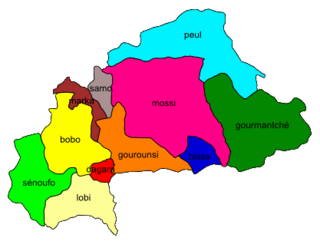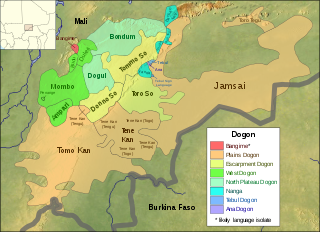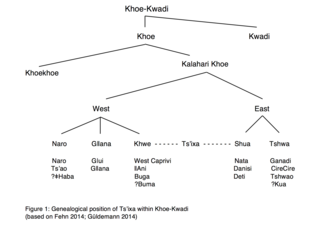Related Research Articles
In linguistics, morphosyntactic alignment is the grammatical relationship between arguments—specifically, between the two arguments of transitive verbs like the dog chased the cat, and the single argument of intransitive verbs like the cat ran away. English has a subject, which merges the more active argument of transitive verbs with the argument of intransitive verbs, leaving the object distinct; other languages may have different strategies, or, rarely, make no distinction at all. Distinctions may be made morphologically, syntactically, or both.
Warrongo is an Australian Aboriginal language, one of the dozen languages of the Maric branch of the Pama–Nyungan family. It was formerly spoken by the Warrongo people in the area around Townsville, Queensland, Australia. Its last native speaker was Alf Palmer, who died in 1981.
Tagalog grammar is the body of rules that describe the structure of expressions in the Tagalog language, the language of the Tagalog region of the Philippines.
Neo-Mandaic, also known as Modern Mandaic, sometimes called the "ratna", is the modern reflex of the Mandaic language, the liturgical language of the Mandaean religious community of Iraq and Iran. Although severely endangered, it survives today as the first language of a small number of Mandaeans in Iran and in the Mandaean diaspora. All Neo-Mandaic speakers are multilingual in the languages of their neighbors, Arabic and Persian, and the influence of these languages upon the grammar of Neo-Mandaic is considerable, particularly in the lexicon and the morphology of the noun. Nevertheless, Neo-Mandaic is more conservative even in these regards than most other Neo-Aramaic languages.
Rapa Nui or Rapanui, also known as Pascuan or Pascuense, is an Eastern Polynesian language of the Austronesian language family. It is spoken on Easter Island, also known as Rapa Nui.

The Natchez language is the ancestral language of the Natchez people who historically inhabited Mississippi and Louisiana, and who now mostly live among the Muscogee and Cherokee peoples in Oklahoma. The language is considered to be either unrelated to other indigenous languages of the Americas or distantly related to the Muskogean languages.
Máku, also spelled Mako, and in the language itself Jukude, is an unclassified language and likely language isolate once spoken on the Brazil–Venezuela border in Roraima along the upper Uraricoera and lower Auari rivers, west of Boa Vista, by the Jukudeitse. 300 years ago, the Jukude territory was between the Padamo and Cunucunuma rivers to the southwest.
While other word categories in Ilocano are not as diverse in forms, verbs are morphologically complex inflecting chiefly for aspect. Ilocano verbs can also be cast in any one of five foci or triggers. In turn, these foci can inflect for different grammatical moods.

Dagaare is the language of the Dagaaba people of Ghana, Burkina Faso, and Ivory Coast. It has been described as a dialect continuum that also includes Waale and Birifor. Dagaare language varies in dialect stemming from other family languages including: Dagbane, Waale, Mabia, Gurene, Mampruli, Kusaal, Buli, Niger-Congo, and many other sub languages resulting in around 3 million Dagaare speakers. Throughout the regions of native Dagaare speakers the dialect comes from Northern, Central, Western, and Southern areas referring to the language differently. Burkina Faso refers to Dagaare as Dagara and Birifor to natives in the Republic of Côte d’Ivoire. The native tongue is still universally known as Dagaare. Amongst the different dialects, the standard for Dagaare is derived from the Central region’s dialect. Southern Dagaare also stems from the Dagaare language and is known to be commonly spoken in Wa and Kaleo.

Bangime is a language isolate spoken by 3,500 ethnic Dogon in seven villages in southern Mali, who call themselves the bàŋɡá–ndɛ̀. Bangande is the name of the ethnicity of this community and their population grows at a rate of 2.5% per year. The Bangande consider themselves to be Dogon, but other Dogon people insist they are not. Bangime is an endangered language classified as 6a - Vigorous by Ethnologue. Long known to be highly divergent from the (other) Dogon languages, it was first proposed as a possible isolate by Blench (2005). Heath and Hantgan have hypothesized that the cliffs surrounding the Bangande valley provided isolation of the language as well as safety for Bangande people. Even though Bangime is not closely related to Dogon languages, the Bangande still consider their language to be Dogon. Hantgan and List report that Bangime speakers seem unaware that it is not mutually intelligible with any Dogon language.
Nambikwara is an indigenous language spoken by the Nambikwara, who reside on federal reserves covering approximately 50,000 square kilometres of land in Mato Grosso and neighbouring parts of Rondonia in Brazil. Due to the fact that the Nambikwara language has such a high proportion of speakers, and the fact that the community has a positive attitude towards the language, it is not considered to be endangered despite the fact that its speakers constitute a small minority of the Brazilian population. For these reasons, UNESCO instead classifies Nambikwara as vulnerable.
The Sabahan languages are a group of Austronesian languages centered on the Bornean province of Sabah.
Papuan Malay or Irian Malay is a Malay-based creole language spoken in the Indonesian part of New Guinea. It emerged as a contact language among tribes in Indonesian New Guinea for trading and daily communication. Nowadays, it has a growing number of native speakers. More recently, the vernacular of Indonesian Papuans has been influenced by Standard Indonesian, the national standard dialect. It is mainly spoken in coastal areas of West Papua alongside 274 other languages.
Trumai is an endangered language isolate of Brazil. Most Trumai are fluent in languages of wider communication, and children are not learning it well.

Iatmul is the language of the Iatmul people, spoken around the Sepik River in the East Sepik Province, northern Papua New Guinea. The Iatmul, however, do not refer to their language by the term Iatmul, but call it gepmakudi.
Aramba (Arammba), also known as Serki or Serkisetavi, is a Papuan language of Papua New Guinea. It is spoken to the south of Western Province in the Trans Fly region. Aramba belongs to the Tonda Sub-Family, which is next to the Nambu Sub-Family region and the Suki language. Alternative names for the language include Upper Morehead, Rouku, Kamindjo and Tjokwasi.
Kelon, or Klon, is a Papuan language of the western tip of Alor Island in the Alor archipelago of East Nusa Tenggara, Indonesia.
The Sabanê language is one of the three major groups of languages spoken in the Nambikwara family. The groups of people who speak this language were located in the extreme north of the Nambikwara territory in the Rondônia and Mato Grosso states of western Brazil, between the Tenente Marques River and Juruena River. Today, most members of the group are found in the Pyreneus de Souza Indigenous Territory in the state of Rondonia.

Toʼabaita, also known as Toqabaqita, Toʼambaita, Malu and Maluʼu, is a language spoken by the people living at the north-western tip of Malaita Island, of South Eastern Solomon Islands. Toʼabaita is an Austronesian language.

Tsʼixa is a critically endangered African language that belongs to the Kalahari Khoe branch of the Khoe-Kwadi language family. The Tsʼixa speech community consists of approximately 200 speakers who live in Botswana on the eastern edge of the Okavango Delta, in the small village of Mababe. They are a foraging society that consists of the ethnically diverse groups commonly subsumed under the names "San", "Bushmen" or "Basarwa". The most common term of self-reference within the community is Xuukhoe or 'people left behind', a rather broad ethnonym roughly equaling San, which is also used by Khwe-speakers in Botswana. Although the affiliation of Tsʼixa within the Khalari Khoe branch, as well as the genetic classification of the Khoisan languages in general, is still unclear, the Khoisan language scholar Tom Güldemann posits in a 2014 article the following genealogical relationships within Khoe-Kwadi, and argues for the status of Tsʼixa as a language in its own right. The language tree to the right presents a possible classification of Tsʼixa within Khoe-Kwadi:
References
- 1 2 Tombonuo at Ethnologue (18th ed., 2015) (subscription required)
- ↑ King, Julie (1984). The Paitanic language family. pp. 146. ISBN 0858832976.
{{cite book}}:|work=ignored (help) - ↑ Lobel, Jason William (2013). Philippine and North Bornean languages: issues in description, subgrouping and reconstruction (PDF) (PHD dissertation). Manoa: University of Hawai'i. p. 370.
- ↑ King, John Wayne (1993). Tombonuwo phonemics. pp. 97–106. ISBN 9789839638059.
{{cite book}}:|work=ignored (help) - ↑ Boutin, Michael (1988). Problems in analyzing focus in the languages of Sabah. p. 54. ISBN 0883122146.
{{cite book}}:|work=ignored (help) - 1 2 3 King, John Wayne; Levinsohn, Stephen (1991). Participant reference in Tombonuo. p. 76. ISBN 0-85883-406-5.
{{cite book}}:|work=ignored (help)